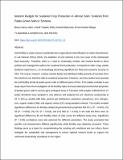Nutrient Budgets for Sustained Crop Production in African Soils: Evidence from Potato-Grown Soils in Tanzania

View/
Date
2024-11-12Author
Aloo, Becky
Tripathi, Vishal
Makumba, Billy
Mbega, Ernest
Metadata
Show full item recordAbstract
Soil fertility is under pressure worldwide due to agricultural intensification to match food demand. In sub-Saharan Africa (SSA), the depletion of soil nutrients is the root cause of the widespread food insecurity. Therefore, there is a need to continually monitor soil nutrient levels to drive policies and management options for sustained food production. Compared to other crops, potato (Solanum tuberosum L.) is increasingly becoming significant for food and economic security in SSA. The crop is, however, a heavy nutrient feeder and withdraws hefty amounts of nutrients from the soil which can interfere with its sustained production. However, very few studies have assessed the soil fertility levels of potato-grown soils in different parts of SSA. This chapter includes a case study report from the investigation of the fertility status and associated physicochemical properties of potato-grown soils in various agro-ecological areas in Tanzania. Soil samples collected from 27 potato farmlands were sampled in nine districts and analyzed for pH, electrical conductivity at 25 °C (EC25), soluble salts (SS), particle size distribution, potassium, phosphorus, iron, nitrogen, zinc, organic matter (OM), and organic carbon (OC) using standard methods. The results revealed significant differences for fertility-related physicochemical properties like EC25 (P = 0.004), (%) SS (P = 0.004), (%) OC (P = 0.018), and (%) OM (P = 0.019) in the soils but there were no significant differences for the fertility status of soils across the different study areas. Significant (P < 0.05) correlations were also observed for different parameters. The study concluded that specific soil characteristics differed significantly while fertility was relatively consistent. These findings serve as a basis for comprehending the existing soil conditions and can inform future strategies for sustainable soil management to ensure optimal nutrient levels to support the continued productivity of potatoes in the region.
URI
https://doi.org/10.1007/978-981-97-5276-8_22https://dspace.nm-aist.ac.tz/handle/20.500.12479/2964
